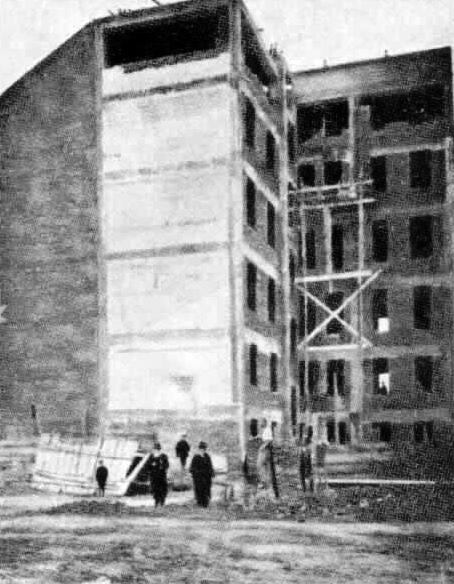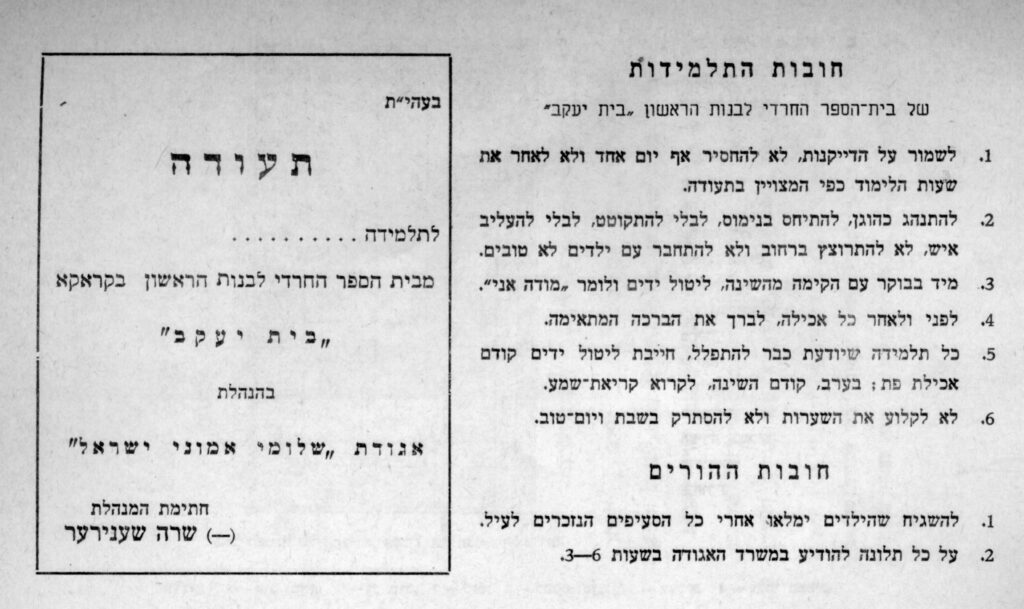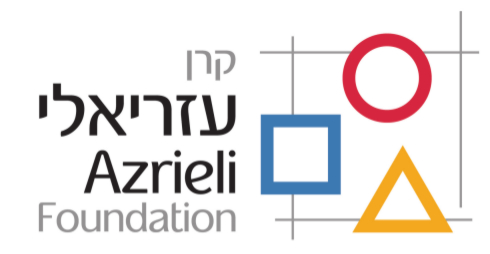100 Years Since the Founding of the First Bais Yaakov Seminar
Originally published in 2022
Stanisława Street 10, Krakow, Poland
Bais Yaakov, the educational revolution that saved generations, was founded by Sarah Schenirer in 5678 (1917-8), as a small school that operated within a private home. After receiving the encouragement and approval of the Gerrer Rebbe, Rabbi Avraham Mordechai Alter z”l, and of the holy Chafetz Chaim z”l (Rabbi Yisrael Meir Kagan), the idea began to take shape and became an extensive and institutionalized network of schools. The need arose to establish a seminar for the training of teachers and educators.
The Bais Yaakov Seminar building, under construction in Krakow
It is said that the first comment by the Imrei Emet (the Gerrer Rebbe) on this initiative, which breathed life into the hearts of thousands of Polish Jews who enrolled their daughters in Bais Yaakov, was in response to a question from a Ger chassid that a building he owned was hosting Bais Yaakov activities. The latter, a chassidic Jew in his roots, did not know what to do with this “loophole,” and came to ask the Imrei Emet, on the advice of his rabbi, how he should proceed.
The response of the Imrei Emet surprised him, and its publication made waves throughout the Jewish world:
“I would be happy if this activity was taking place in my own home.” (Sheh’oni Belevavechem, Pearl Benisch)
As mentioned, the accelerated development of the school network led Sarah Schenirer, the life spirit of Bais Yaakov, to open a seminar for teachers, and with the support of Agudath Israel, the first branch was opened in the summer of 5682 (1922), exactly one hundred years ago, at 10 Stanisława Street in Krakow. Later, as the institution grew and developed in quantity and quality, the seminary was recognized as an official institution by the Polish Ministry of Education, and a desperate need for a much larger building was soon felt, and Agudath Israel purchased the large building at 30 Augustianska Street, where extensive and vibrant activities took place until the outbreak of the terrible war that crippled the foundations of the Jews in Europe and in which tens of thousands of teachers, students, and graduates of Bais Yaakov were killed.
225 Bais Yaakov schools operated in Europe before the Holocaust, and over 35,000 students were educated in them.
“Classes in Bais Yaakov schools reshaped the image of a daughter, mother, and family, largely under the inspiration of the highly charismatic founder and her vision. She was able to inculcate her sense of an educational mission in her students, along with the courage to act resolutely. She also passed on to them the mission of proudly achieving kiddush Hashem (sanctifying the Name of G-d) throughout their lives. The fact that one woman managed, in such a brief time, to effect such a revolution gave them the courage they needed as young teachers and principals in a society that was not always sympathetic. Her ideas spread fairly quickly until World War II put an end to official education in the movement’s schools; from then on the young alumnae faced the tough test of the Holocaust.”
(Esther Farbstein – Hidden in Thunder, pg. 689)
S. Laks, in his book “HaYehudim B’Krakow,” tells about the seminar (couresty of Matach – the Virtual Library):
“At the initiative of Sarah Schenirer and with the support of the leaders of Agudath Israel, who were convinced by her, the first high school for charedi (ultra-Orthodox) girls was founded in Krakow in 1917. The goal of this special school, the Bais Yaakov school, was to educate Jewish girls in the spirit of Torah and Judaism, in order to prevent a growing number of charedi girls from abandoning tradition and the path of the Torah. This institution developed in a short time, and not least thanks to the efforts of Sarah Schenirer, into an extensive network of over 50 such schools in various towns and cities in Poland.”
“The success of the enterprise led, a few years later, and as a natural and necessary continuation, to the establishment of a seminar for teachers in Krakow in 1922. (The idea for establishing the seminar was given by Rabbi Meir Shapira, founder of the ‘Chachmei Lublin Yeshiva,’ during the discussions of the Agudath Israel conference.) The purpose of the seminar was to train charedi girls who had graduated from high school, for education, guidance, and teaching in Bais Yaakov schools.”
“The seminar had a dormintory where girls from outside Krakow lived (all the girls spent Shabbat and holidays together – those from Krakow and those from outside). A graduate of a recognized high school, a religious girl from a religious home, who had a recommendation from people who knew her as religious and who had passed strict exams by the teachers’ committee could be admitted to the seminar. The first three months were a probationary period, after which the candidate could continue her studies at the seminar.”
“The schooling period was two years. They studied theoretical subjects as well as pedagogy. But the main thing was, of course, the study of Torah and Judaism, including its laws, teachings, and chapters. The school day was long and very concentrated. Every morning, the boarding school girls had to get up at 6:00 AM, tidy their rooms, and enter the prayer room (which, due to its red walls, was called the “Red Room”), and pray the Shacharit service.”
“On Friday nights, on Shabbat, and on holidays, the girls went to pray in various synagogues, but mainly to the Rema synagogue. After having breakfast together, they studied in classrooms until one o’clock in the afternoon. After the prayers, they ate lunch. After the meal, there was rest time until three o’clock, when the girls had to go for a walk in the garden next to the seminar (called the ‘Garden of Kings’, and the vegetation in it was unique). The rest and the walk were very important because from four o’clock there were three more hours of study. The time after the Maariv prayer and dinner until ten o’clock at night was designated for preparing lessons, and at ten o’clock it was time for lights out.”
“Mainly female teachers taught at the seminar (there were also a number of lecturers such as Dr. Deutschlander, the director of the World Torah Foundation, and Rabbi Yehuda Leib Orlean). The majority of the teaching staff were volunteer pedagogy experts who came from charedi Jewry in Germany (mainly from Frankfurt-am-Main). Most of the female teachers lived on a different floor from the girls’ rooms.”
“Discipline at the seminar was mainly internal discipline- although Dr. Rosenbaum (who was called ‘Fraulein Doctor’ – due to her young age, beauty, and appearance) also maintained formal discipline (there was almost no contact with the city, because the principal was very careful that the girls did not wander the streets). The girls’ internal discipline stemmed from a sense of purpose, a feeling they had from the beginning of their studies at the seminar, which was also expressed in the fact that after they completed their studies at the seminary, they remained, almost without exception, in the educational system of the Bais Yaakov schools and taught wherever they were sent by the seminar administration. The ‘atmosphere’ of discipline not only did not interfere, but also helped to create a sisterhood and mutual assistance that prevailed within the walls of the seminar.”
“Initially, about 120 girls studied at the seminary. After the construction of the new 6-story building (in 1932), with large classrooms, the number of girls reached a peak of about 450 girls in the second half of the 1930s. The seminar’s reputation was so great that people came to study here from distant countries, such as England and even the United States – because it was a globally unique institution.”
“The living spirit of the entire Bais Yaakov educational system was, as mentioned, Sarah Schenirer, her entire life was dedicated to the work of religious education (she addressed the girls in the seminar as “my daughters”). She worked day and night, slept only 3-4 hours a day, and at night she answered the many letters that the seminar graduates, now teachers, used to send her. She traveled from city to city throughout Poland to participate in the exams of Bais Yaakov students; she even prepared study materials for use in the seminar. Sarah Schenirer passed away in 1935 at the height of the development of the charedi educational system in Poland, a system to which she had contributed so much.”
The Bais Yaakov students absorbed indescribable values of faith and Jewish strength, which was reflected in their inspiring coping mechanisms during the Holocaust. (The best-selling books “To Vanquish the Dragon” and “Carry Me in Your Heart” – both by Perl Benisch – extensively tell the story of the Bais Yaakov students and how they coped with the harshest of circumstances since the dawn of history. These books, by the way, are highly recommended for all ages. The English and Hebrew editions of the books were considered bestsellers throughout the Jewish diaspora for many years.)
The cover of the certificate issued to the students of the Bais Yaakov school in the city of Krakow. On the right side are the rules and regulations for the students.
At the outbreak of war, on the orders of the Germans, the seminar’s gates were closed, and its director (since the death of Sarah Schenirer in 5695 – 1935), Rabbi Yehuda Leib Orlean, a highly educated man from among the best of Ger chassidim, opened a network of secret schools that dedicately operated underground.
The Bais Yaakov Seminar for teachers in Krakow
Rabbi Orlean, a spiritual man who was like the father to Jewish girls, was their support even in times of trouble, and springs of strength and power flowed from his pure heart and strengthened countless students whose youthful joys were cut off by the terrible Holocaust and brought upon them the disaster of bereavement and loss.
Eighty years ago, at the end of Sivan 5702 (spring 1942), a gathering of rabbis was arranged, headed by Rabbi Orlean and Rabbi Menachem Ziemda, from the great rabbis of Ger chassidism, whose names are connected with lives of dedication and sanctifying the Name of G-d during the “years in which we saw evil.”
Rabbi Orlean was beaten and tortured during the Holocaust, and was killed in sanctification of G-d’s Name on Simchat Torah 5704 (1943). In the future, we will delve into his educational activities during the Holocaust, and on his tragic end, as well as that of his wife and six children.
Rabbi Alexander Zusha Friedman, one of the greatest rabbis and thinkers in Poland, was also one of the leaders of Bais Yaakov and often lectured to female educators and students. He also had an indescribable influence on an entire generation of girls and adults who went to their deaths with pure and clear faith and while saying the “Shema Yisrael” prayer (Hear Oh Israel). The wife and children of Rabbi Friedman, author of the renowned book “Maayanei Shel Torah” (From the Fountain of Torah), were brutally murdered exactly eighty years ago, in the summer of 5702 (1942), but the rabbi himself did not sink into the abyss of sadness and despair, but continued to work in the field of education and sprinkle the dew of revival on the faces of countless male and female students.
He too met his death during the Holocaust, but left a strong mark at the time and on future generations. In 5682 (1921-2), a hundred years ago, when the idea of Bais Yaakov began to take root, Rabbi Friedman wrote his book “Bais Yaakov – A Call to the Women and Daughters of Israel.”
The book, in a luxurious and well-written edition, in Yiddish, addressed the Jewish women in clear language and in an organized manner, words spoken on their own terms, and described to them Jewish history and the magnitude of the hour, then, in the turbulent days between the two wars, when Bais Yaakov stood at the forefront of the desperate struggle against assimilation and secularization trends, and succeeded in stopping the negative trends.
The book on the Hebrew Books website: https://hebrewbooks.org/36265
And for those who understand Yiddish, it is recommended to read this book from page 4 onwards. There are chilling lines drawn there, terrible descriptions of the dedication of the Jewish soul, of the bloodshed, of the hangings and strangulations, of the slaughter and the cry of “Shema Yisrael”… terrible lines that raise the obvious question: How did the author know how to describe what was to happen to him and his generation some twenty years later?
May their souls be bound in the bonds of life.
















